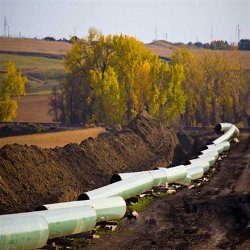A focal point in North Dakota right now is pipelines – or, should I say, lack thereof. North Dakota oil and gas production is booming each and every day as it continues to reach all-time highs.
As a result, North Dakota’s pipeline system is maxed to capacity. It leaves us wondering when we’re going to see more pipelines thrown into the mix.
 The problem: we can’t even ensure that pipelines currently online are being regulated properly. And while the need to expand the pipeline system continues to grow, it’s becoming an ever pressing issue, both locally and on a national scale.
The problem: we can’t even ensure that pipelines currently online are being regulated properly. And while the need to expand the pipeline system continues to grow, it’s becoming an ever pressing issue, both locally and on a national scale.
Mounting further frustrations, a North Dakota oil spill last month heats up the debate. Again, people want answers about the lack of forward progress of TransCanada Corp’s (NYSE: TRP) Keystone XL Pipeline and why on earth the government is so sluggish on pipeline safety measures.
It’s been three whole years now since promises were made to the American people that regulators would tackle pipeline safety. And we’re still waiting…
Those promises came after an oil pipeline ruptured in Michigan, spilling 843,000 gallons of sludge. From that point on, we were told that operators would tighten their monitoring of pipes for possible leaks, and new rules would be drawn up. We’re still waiting…
That spill – part of an Enbridge Energy Partners (NYSE: EEP) pipeline – is the nation’s most expensive onshore oil spill to date. The worst part: the nation’s largest transporter of Canadian crude knew about the leak and didn’t do a thing about it until 17 hours after it was discovered.
In North Dakota, where there is a lot more action taking place, we can’t afford to make those same mistakes. As production increases, so must inspections.
Still waiting…
Government Action
The U.S. Pipeline and Hazardous Materials Safety Administration (PHMSA) is running the show, and of the items it said it would prioritize, it has only fallen short. The agency contends it is “working on it.”
Supposedly, the PHMSA has plans for all 185,000 miles of pipeline that it oversees with a reconfigured set of rules, according to Bloomberg. It’s true, the number of serious pipeline incidents has fallen since the 1990s, but even then, since the Michigan incident in 2010, there have been 96 incidents that caused 42 fatalities, an additional 200 injuries, and roughly $400 million in property damage.
Even if the PHMSA is ironing out its new regulations, it’s taking too long. After Michigan, it was supposed to rewrite the rules for leak detection and cut-off valves. It didn’t. And last month’s spill that I mentioned, a 20,000 barrel spill at a Tesoro Corp (NYSE: TSO) pipeline, would have gone undetected if it weren’t for a farmer finding it in his field.
Luckily, we have Congress. It passed legislation in 2011 that made it mandatory for the PHMSA to study leak protection and make new rules, accordingly. The findings, according to Bloomberg, showed that of the 766 pipeline incidents between Jan. 1, 2010 and July 7, 2012, only 23 were detected by monitors. Typically, it was outside sources that made the discoveries.
And for some reason, pipeline leak-detection system technology hasn’t advanced like it should in the U.S. So riddle me this – why does Canada have the technology? Like I said, luckily we have Congress.
But the PHMSA does have some sort of proposal it has sent for approval by the Office of Transportation Secretary Anthony Foxx, which will then be sent to the White House Office of Management and Budget for review.
It’s ironic how new pipelines are continually shot down for approval on claims of safety issues, but the government fails to address those very issues.
Let’s hope they can get it right and it’s not just sitting on somebody’s desk with a big stack of papers.
I won’t be holding my breath.
Our analysts have traveled the world over, dedicated to finding the best and most profitable investments in the global energy markets. All you have to do to join our Energy and Capital investment community is sign up for the daily newsletter below.
Keep it Moving
I guess that’s as good a reason as any for why the President won’t approve more pipeline infrastructure like the Keystone XL. We can’t even manage what we already have. That must change, as the U.S. will depend on pipelines more and more during the boom.
But applications will keep coming, and one day they’re going to stick. One company just filed an application for a 610-mile pipeline that would carry 200,000 barrels of oil per day from North Dakota’s Bakken to Superior, Wisconsin.
That will take a year just to go through public review.
As for TransCanada’s Keystone XL pipeline that would transport oil from Alberta, Canada to the Gulf of Mexico, the debate will rage on.
Pipelines are the safest form of oil and gas transportation, much more so than train, truck, or barge, but they still need to be regulated.
Once regulation is in place, then we can start thinking about the approval of additional pipelines that are desperately needed.
Until then, we’re still waiting…
If you liked this article, you might also enjoy:




